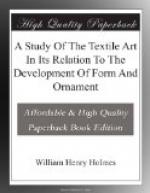[Illustration: FIG. 356. Ceremonial adz, with carved ornament imitating textile wrapping. Polynesian work.]
Textile materials are very generally associated with the human figure in art, and thus sculpture, which deals chiefly with the human form, becomes familiar with geometric motives and acquires them. Through sculpture these motives enter architecture. But textile decoration pervades architecture before the sculptor’s chisel begins to carve ornament in stone and before architecture has developed of itself the rudiments of a system of surface embellishment. Textile art in mats, covers, shelters, and draperies is intimately associated with floors and walls of houses, and the textile devices are in time transferred to the stone and plaster. The wall of an ancient Pueblo estufa, or ceremonial chamber, built in the pre-esthetic period of architecture, antedating, in stage of culture, the first known step in Egyptian art, is encircled by a band of painted figures, borrowed, like those of the pottery, from a textile source. The doorway or rather entrance to the rude hovel of a Navajo Indian is closed by a blanket of native make, unsurpassed in execution and exhibiting conventional designs of a high order.
[Illustration: FIG. 357. Portion of a tapa stamp, showing its subtextile character. A palm leaf is cut to the desired shape and the patterns are sewed in or stitched on.]
[Illustration: FIG. 358. Design in stucco, exhibiting textile characters.]
The ancient “hall of the arabesques” at Chimu, Peru, is decorated in elaborate designs that could only have arisen in the textile art (Fig. 358), and other equally striking examples are to be found in other American countries. The classic surface decorations known and used in Oriental countries from time immemorial prevailed in indigenous American architecture at a stage of culture lower than any known stage of classic art.
It may appear that I have advocated too strongly the claims of the textile art to the parentage of geometric ornament and that the conclusions reached are not entirely satisfactory, but I have endeavored so to present the varied phenomena of the art that the student may readily reach deductions of his own. A correspondingly careful study of other branches of art will probably enable us finally to form a just estimate of the relative importance of the forces and tendencies concerned in the evolution of decoration.
* * * * *
INDEX
Alaskan Indians, illustration of ornamentation by
199
Ancon, Peru, examples of ornamentation from graves
at 212, 230,
231, 236, 243, 248
Apache, illustrations of ornamentation by 198, 213,
223
British Guiana Indians, illustrations of ornamentation
by 217
Chimu, Peru, ornamentation of “hall of arabesques”
at 251, 252
Clallam Indians, illustrations of ornamentation by




